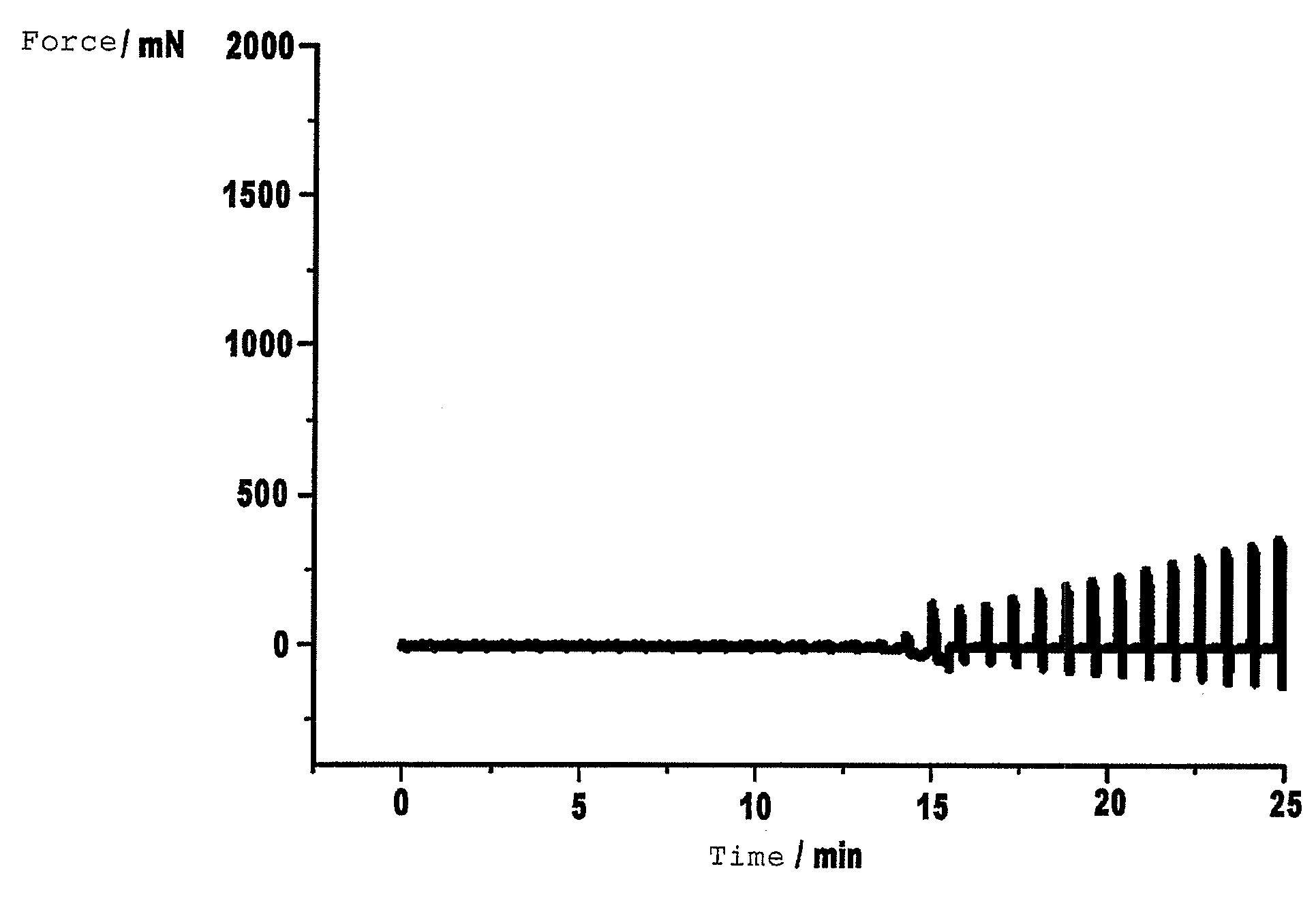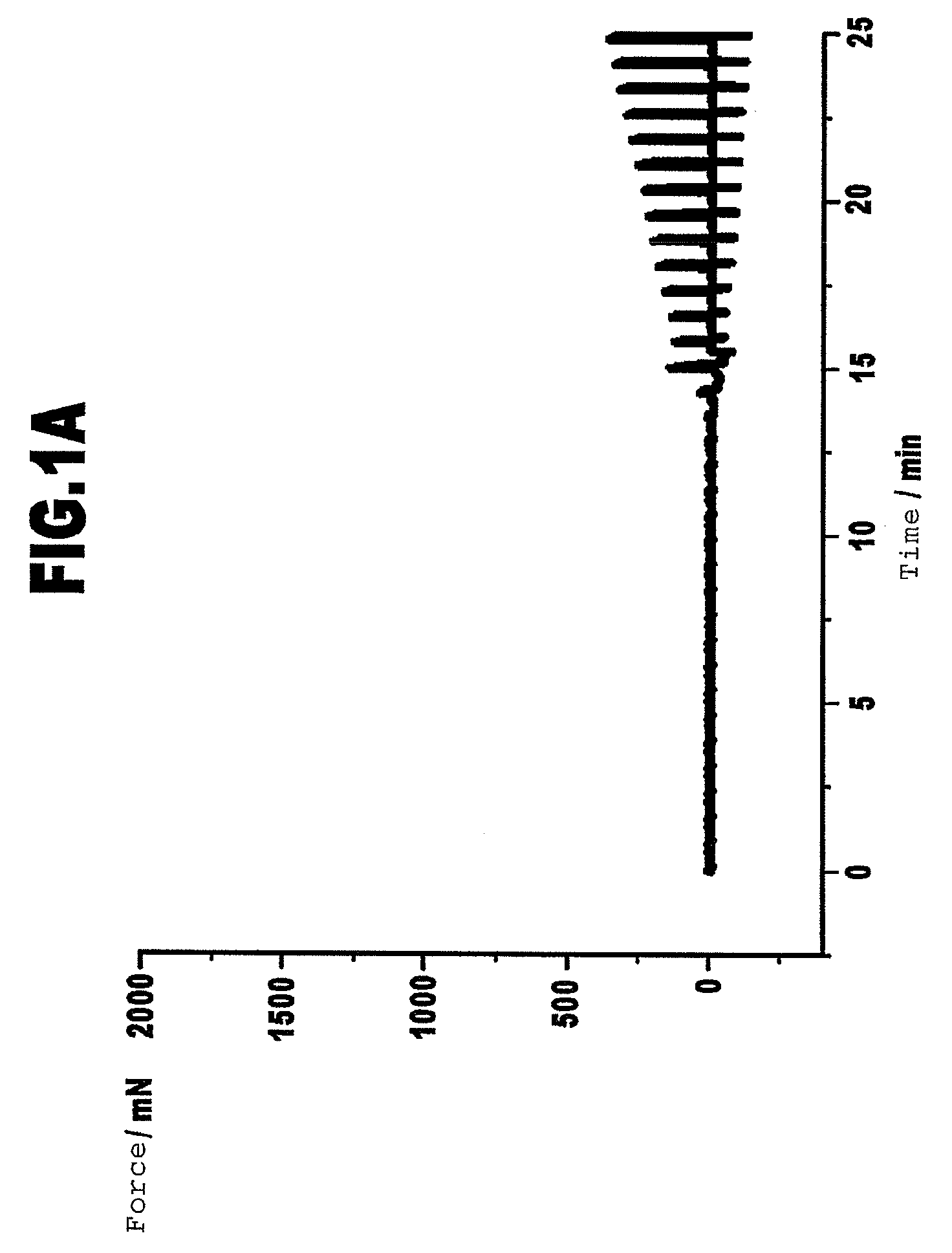Use of gelatin and a cross-linking agent for producing cross-linking medical glues
a cross-linking agent and gelatin technology, applied in the field of innovative, can solve the problems of affecting the production efficiency affecting the quality of cross-linking medical glues, and affecting the application of gels, etc., and achieves the effects of simple and less expensive production, increased viscosity of glues, and high viscidity
- Summary
- Abstract
- Description
- Claims
- Application Information
AI Technical Summary
Benefits of technology
Problems solved by technology
Method used
Image
Examples
example 1
Cross-Linkage of Gelatin with Transglutaminase: Effect of the Viscosity of the Gelatin
[0105]As a model system for the medical application of the glue according to the invention the cross-linkage of gelatin with the enzymatic cross-linking agent transglutaminase was conducted in vitro and the kinetics of the formation of a cross-linked gelatin gel determined.
Production of a Transglutaminase Stock Solution
[0106]A recombinant transglutaminase from human keratinocytes was used for this example and those described below.
[0107]A stock solution of transglutaminase with a concentration of 30 units / ml was produced by dissolving the corresponding amount of the enzyme in distilled water at room temperature. The solution was sterilised by filtration, frozen in portions of 1.5 ml each using liquid nitrogen and stored at approximately −18° C.
Thermal Pretreatment of Gelatin at Reduced Pressure
[0108]For the cross-linkage with transglutaminase, pig skin gelatins with different viscosities were used ...
example 2
Cross-Linkage of Gelatin with Transglutaminase: Effect of the Gelatin Concentration
[0121]In this example the thermally pretreated gelatin C from Example 1 was cross-linked with different gelatin concentrations with transglutaminase. The preparation of the reaction mixtures and the measurement of the gel strength were conducted as described in Example 1.
[0122]The concentration of the gelatin solutions used, the composition of the reaction mixtures and the gel point resulting from the gel strength measurement are shown in the following Table 3.
[0123]The gel strength and adhesion in relation to area 10 min after the gel point are additionally specified.
TABLE 3Batch2-12-22-32-4Concentration of the5%by wt.8%by wt.10%by wt.12.7%by wt.gelatin solutionGelatin solution5.9ml5.9ml5ml5.9mlTransglutaminase0.2ml0.3ml0.3ml0.5mlstock solutionDistilled water——0.9ml—Transglutaminase per20.3units / g19.1units / g18.0units / g20units / ggram of gelatinGel point5.0min4.0min3.3min2.0minGel strength after 10 min2...
example 3
Cross-Linkage of Gelatin with Transglutaminase: Effect of the Quantity of Cross-Linking Agent
[0126]In this example the thermally pretreated gelatin C from Example 1 was cross-linked with different quantities of transglutaminase.
[0127]An 8% by wt. solution of gelatin C was produced as described in Example 1. For each batch 5.9 ml of this solution were preheated to 37° C. and mixed with the quantity of transglutaminase stock solution (30 units / ml heated to 37° C.) specified in the following Table 4 in order to start the cross-linkage reaction. The determination of the gel point by means of the gel strength measurement occurred as described in Example 1.
TABLE 4Batch3-13-23-3Quantity of0.2ml0.3ml0.5mlTransglutaminasestock solutionTransglutaminase12.7units / g19.1units / g31.8units / gper gram of gelatinGel point6.0min4.0min3.0min
[0128]As can be seen from the values specified in Table 4, the rate of formation of the cross-linked gelatin gel can also be influenced by the concentration of the cr...
PUM
| Property | Measurement | Unit |
|---|---|---|
| diameter | aaaaa | aaaaa |
| diameter | aaaaa | aaaaa |
| gel strength | aaaaa | aaaaa |
Abstract
Description
Claims
Application Information
 Login to View More
Login to View More - R&D
- Intellectual Property
- Life Sciences
- Materials
- Tech Scout
- Unparalleled Data Quality
- Higher Quality Content
- 60% Fewer Hallucinations
Browse by: Latest US Patents, China's latest patents, Technical Efficacy Thesaurus, Application Domain, Technology Topic, Popular Technical Reports.
© 2025 PatSnap. All rights reserved.Legal|Privacy policy|Modern Slavery Act Transparency Statement|Sitemap|About US| Contact US: help@patsnap.com



